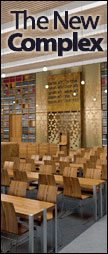5785: The Rarest Year of Them All Part XIII - Handling Haftaros
As detailed in previous installments in our series, our current year, 5785, is not only a rare one, but calendarically speaking, actually the hands-down rarest of them all. 5785 is classified as a HaSh”A year in our calendars. This abbreviation is referring to Rosh Hashana falling out on Thursday (hei), both months of Cheshvan and Kislev being shalem (shin - 30 day months instead of possibly 29; these are the only months that can switch off in our set calendar), and Pesach falling out on Sunday (aleph).
A HaSh”A year is the rarest of years, and out of the 14 possibilities in Tur’s 247-year calendar cycle, this year type occurs on average only once in about 30.19 years (approximately 3.3 percent of the time). Indeed, at times there are 71 years (!) in between HaSh”A years. The last time this year type occurred was 31 years ago in 5754/1994. The next time will be 20 years hence in 5805/2044. The next several times after that are slated to be 27 years further, in 5832/2071 and then a 51 year gap in 5883/2122.
The reasons and rules governing the whys and whens this transpires are too complicated for this discussion; suffice to say that when the Mishnah Berurah discusses these issues he writes “ain kan makom l’ha’arich,” that this is not the place to expound in detail, which is certainly good enough for this author.
Obviously, such a rare calendar year will contain many rare occurrences. This series details many of them. Let’s continue on our journey through our unique year.
Delayed Shabbos-Rosh Chodesh Haftara?
The first Shabbos Rosh Chodesh of 5785 was Rosh Chodesh Marcheshvan, Parashas Noach – in which the haftarah for Shabbos Rosh Chodesh “Hashamayim Kisi” (Yeshaya Ch.66:1) was leined. However, although there are and will be several more Shabbosei Rosh Chodesh over the course of this year, nonetheless, this special haftarah will not be leined for another year and a half from its previous reading right after Sukkos. The second Shabbos Rosh Chodesh this year was Rosh Chodesh Adar, which also was Parashas Shekalim, which as one of the Arba Parshiyos, knocked off any other haftarah. Yet, the third occurrence of Shabbos Rosh Chodesh, the upcoming Shabbos Rosh Chodesh Av, is when it gets interesting.
As we know, most haftaros share some similarity with at least one concept presented in the Torah reading. The Gemara Megillah discusses the proper haftarah readings for the various holidays throughout the year. The Gemara (Megillah 29b-31a) states that whenever Rosh Chodesh falls out on Shabbos, the special haftarah of “Hashamayim Kisi,” is read, as it mentions both the inyanim of Shabbos and Rosh Chodesh.
Head-To-Head Haftaros
Our dilemma arises when that rule goes head-to-head with another rule. The Pesikta, (an early Midrash cited by many early authorities) continues the teachings of Chazal as to the proper haftarah readings starting from the Fast of Shiva Assur B’Tamuz.
“During the ‘Three Weeks’ from 17 Tamuz until Tisha B’Av, we read ‘T’lasa D’Paranusa,’ ‘Three Readings of Misfortune.’ After Tisha B’Av (starting with Shabbos Nachamu, dubbed so due to its haftarah, Nachamu Nachamu Ami) until Rosh Hashana, ‘Shiva D’Nechemta’, or ‘Seven Readings of Consolation’ are read. This is followed by a reading of Teshuva, during the Shabbos between Rosh Hashana and Yom Kippur, aptly named ‘Shabbos Shuva,’ for its repentance themed haftarah starting with ‘Shuva Yisrael.’”
The Abudraham as well as Rabbeinu Tam, conclude that these special haftarah readings are so important, that they are never pushed off!
The $64,000 question becomes, what happens when Rosh Chodesh Av falls out on Shabbos? Which ruling trumps which? Do we follow the Gemara or the Pesikta? Do we stick with the ‘T’lasa D’Paranusa’ or the special Rosh Chodesh reading?
The answer is that there is no easy answer! The Beis Yosef (O.C. 425:1 s.v. umashekasav) writes that the ikar halacha follows the Abudraham as he was considered the expert in these topics. Consequently, in the Shulchan Aruch, he only mentions that during the “Three Weeks” the ‘T’lasa D’Paranusa’ are read. Hence on Shabbos Rosh Chodesh Av, the Sefardic minhag is to only read the regularly scheduled haftarah of “Misfortune”: “Shimu,” (Yirmiyahu Ch. 2:4; along with the first and last pasuk of Hashamayim Kisi).
Prague vs. Posen
Yet, figuring out the Ashkenazic minhag is not so simple. Aside from this being a divergence of minhag between the cities of Prague and Posen, as well as a machlokes Rishonim, it is also a machlokes of Tosafos in different Masechtos. And although several Poskim conclude that whichever of the two haftaros is read is fine, nevertheless, the majority consensus seems to be that the minhag to read “Shimu” is the most prevalent, following the Mishnah Berurah’s (425:8) citing of the Vilna Gaon’s position as the final word on the matter. Although in other year make-ups Sefardic and Ashkenazic minhag diverge on this point, nonetheless, on a practical level, this year, they concur.
Accordingly, to most of the world, the special Shabbos Rosh Chodesh haftarah of “Hashamayim Kisi” will not be read from the beginning of 5785 all the way until Parashas Tazria-Metzora, Shabbos Rosh Chodesh Iyar 5786 - eighteen months later. [This is due to the next Shabbos Rosh Chodesh, Shabbos Rosh Chodesh Teves 5786 being on Chanuka, so Chanuka’s haftarah trumps it due to Pirsumei Nissa (publicizing the Chanuka miracle); hence, for most of Klal Yisrael, ‘Hashamayim Kisi’ will practically not be leined until Shabbos Rosh Chodesh Iyar 5786.]
Similar will occur this year regarding “Machar Chodesh,” the special haftarah ordinarily read on Shabbos directly preceding a Sunday Rosh Chodesh, which was leined as the haftarah for Parashas Toldos earlier this year, and will not be read again by the majority of Klal Yisrael until Parashas Bamidbar 5786, a year and a half later. [This is due to its being pushed off for Parashas Hachodesh, Shiva D’Nechemta, and two-day Rosh Chodeshes respectively, the next few times that a Sunday Rosh Chodesh will occur over the next year. Hence, it is not until the next Parashas Bamidbar, when “Machar Chodesh” will be read.]
Our fascinating journey detailing the many remarkable facets of our rare year will iy”H be continued…
Rav Samson Raphael Hirsch famously wrote that “the Jew’s catechism is his calendar.” It is this author’s wish that by showcasing the uniqueness of our calendar year and its rare minhagim, this article will help raise appreciation of them and our fascinating calendarical customs.
This author wishes to thank R’ Yosef Yehuda Weber, author of ‘Understanding the Jewish Calendar,’ for being a fount of calendarical knowledge and for his assistance with this series.






